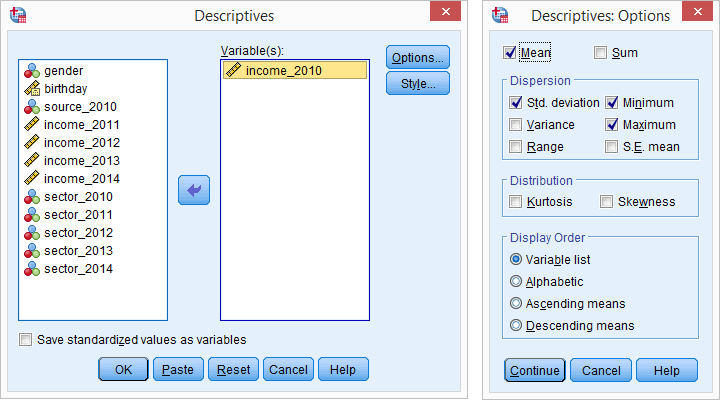

#Spss statistics tutorial how to
So how to analyze your data in SPSS? Well, one option is using SPSS’ elaborate menu options.įor instance, if our data contain a variable holding respondents’ incomes over 2010, we can compute the average income by navigating to D escriptive Statistics as shown below.ĭoing so opens a dialog box in which we select one or many variables and one or several statistics we'd like to inspect. Right, so SPSS can open all sorts of data and display them -and their metadata- in two sheets in its Data Editor window. This is generally known as the “codebook” but in SPSS it's called the dictionary.įor non SPSS users, the look and feel of SPSS’ Data Editor window probably come closest to an Excel workbook containing two different but strongly related sheets. Metadata is information about the meaning of variables and data values. It shows the metadata associated with the data. SPSS Variable ViewĪn SPSS data file always has a second sheet called variable view. A more detailed explanation on the exact meaning of our variables and data values is found in a second sheet shown below. For instance, our first record seems to contain a male respondent from 1979 and so on. This sheet -called data view- always displays our data values. SPSS Data ViewĪfter opening data, SPSS displays them in a spreadsheet-like fashion as shown in the screenshot below from freelancers.sav. Let's now have a quick look at what SPSS looks and feels like. spreadsheets from MS Excel or OpenOffice.SPSS can open all file formats that are commonly used for structured data such as These data may come from basically any source: scientific research, a customer database, Google Analytics or even the server log files of a website.
#Spss statistics tutorial software
SPSS is software for editing and analyzing all sorts of data. Since SPSS was acquired by IBM in 2009, it's officially known as IBM SPSS Statistics but most users still just refer to it as “SPSS”. SPSS means “ Statistical Package for the Social Sciences” and was first launched in 1968. These are the test we use when our data fails to meet one of the four assumptions recommended for the parametricity.SPSS – What Is It? report this ad By Ruben Geert van den Berg under Basics For example, mann whitney u test or most popular chi square test.

The practical use of statistics is to draw inference from the numerical data. So apart from interpretation, we should use inference. We also use SPSS to calculate the descriptive statistics, but most often, we work with the interpretation of numerical data, and we try to draw certain inferences based on the available data.they all examples of descriptive statistics.

So mean, median, standard deviation, percentile, etc. For example, suppose we are discussing the marks obtained by the student in the examination, we might be interested in the average marks scored by the student, or the spread or division of the marks.


 0 kommentar(er)
0 kommentar(er)
